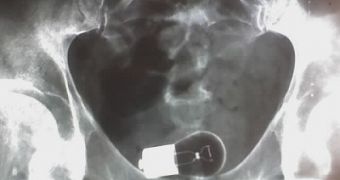Introducing foreign bodies into the rectum, penis, and vagina, can be cultural or just for sex. In some cases of rape this 'practice' has been reported. But when the 'stirrer' is too much alcohol...
Medical reports signal a large array of objects being pulled out from the patients' a*ses, including stones, coke bottles, plastic vibrators, pencils, sticks, a baseball, knives, screwdrivers, the U-bend of a sink, a sponge rubber ball, glass tumblers, a pickle bottle, and a beer glass.
This adds to the list: a 100-watt electric bulb. The 54-year-old man, embarrassed and reluctant to reveal his problem, complained that two days earlier, after having a glass too many, he "did something" to his rectum. The X-ray examination showed that the "something" was a hard, smooth, globular mass. The patient had to admit that he was carrying an electric bulb in his rectum for two days. The 100-watt electric bulb reached that placement following a $100 bet that the man made while the man was heavily drunk.
He managed this by employing shaving cream as lubricant, but the next day, he realized that the bulb won't come out. After two days of difficulties in defecating and urinating, he was forced to seek for medical help.
The doctors located the bulb in the rectum with AP and lateral films and the patient was placed in a face-down position with his hips elevated for the surgery.
A circular metal ring held the buttocks apart but even if visualized, the doctors could not manually extract the bulb, as it could not be gripped over its maximum diameter. Suction cup ends drew the bulb to the sphincter. The suction cup ends had to be attached to the bulb with cyanoacrylate cement. Four attempts resulted unsuccessful, as the cement did not attach, but a fifth attempt was successful without using any glue, and the bulb was dragged to the sphincter.
Three catheters with 30-cc terminal balloons, lubricated with mineral oil, gripped the bulb over the maximum diameter of the bulb at the six, ten and two o'clock positions. Meanwhile, a steady pull was maintained on the attached dart.
After the catheters' tips and balloons went beyond the maximum diameter of the bulb, the balloons were inflated with 30 cc of water, and approximately 30 cc of mineral oil was pumped into the rectum through one of the catheters. Each catheter applied a steady pull of about five pounds (2.25 kg), and after about 10 minutes, the sphincter started to relax, allowing the safe passage of the bulb, without any complication. No bleeding or other injury was inflicted to the rectal mucosa. After 24 hours, the patient left the hospital.
Even if various methods that have been described for pulling out foreign bodies from the rectum, the issue with the electric bulb was its size (maximum diameter of 61 mm; total length, 114 mm) and the fragile glass it was made of. If the glass had broken, it would have provoked rectal lacerations to the rectum and nearby tissues, with severe complications.
Had the removal through the anus not been possible, an abdomen section would have been required and the bulb headed through the rectum and the anus, gently, to avoid injuring the rectum. If this had not worked, colon incision would have been required, a lengthy and severe procedure, with a prolonged recovery period.
So, watch out: too much booze will 'kick your a*s'!

 14 DAY TRIAL //
14 DAY TRIAL //